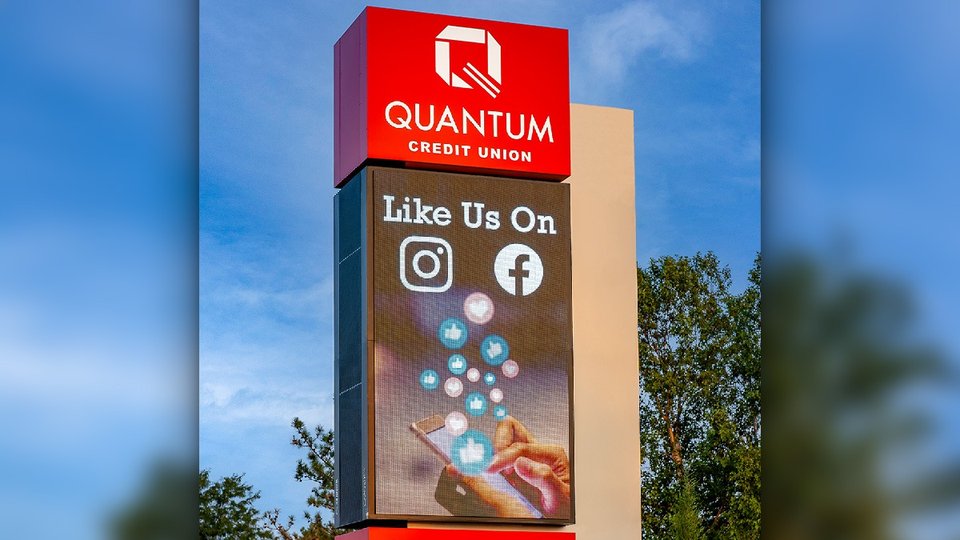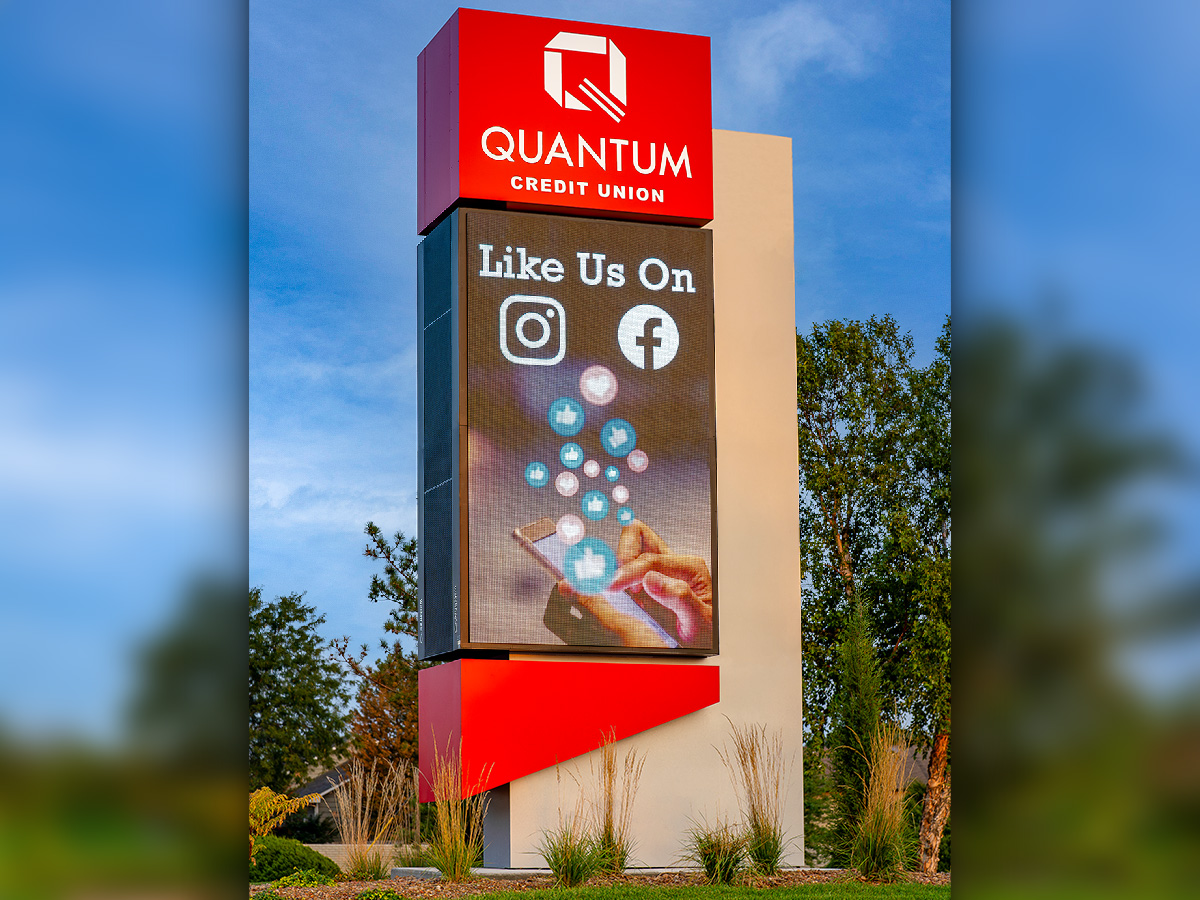Content
Quantum Credit Union enlists Watchfire in digital transformation
Quantum Credit Union partnered with integrator Luminous Neon and Watchfire Signs in its digital signage transformation project this summer. We reached out to learn more from all three partners.

September 11, 2024 by Daniel Brown — Editor, Networld Media Group
Quantum Credit Union, a financial institution based in Wichita, Kansas, recently partnered with Watchfire Signs and integrator Luminous Neon to complete its summertime digital transformation project.
As reported by Digital Signage Today, Quantum Credit Union installed a 6mm, 10'3" x 6'5" Watchfire digital display, which has been used to highlight content such as the credit union's partnership supporting the Kansas Humane Society.
We reached out to representatives of all three partners to learn more about the project via email interview.
Q&A with Chuck Carson, senior account manager at Luminous Neon
Q: For those who are new to your organization, can you briefly share a bit about your history and mission?
Carson: Since 1928, we've been an integral part of Kansas's business landscape. Over the past 96 years, we've grown from our humble beginnings to now serve communities through seven locations strategically placed across the state.
Our mission is simple yet powerful: to be a trusted partner for our customers. We don't just provide services; we build lasting relationships. Our team works closely with each client, ensuring we understand their unique needs and help them make informed decisions that best serve their business interests.
What sets us apart is our deep well of expertise. Our team collectively brings over 1,250 years of industry experience to the table. This wealth of knowledge allows us to offer unparalleled support and guidance through every step of the process.
Q: How did you get involved with the Quantum Credit Union Project?
Carson: We were initially contacted by Quantum Credit Union for a different branch project. As the relationship developed, the focus shifted to their Wichita location. They saw the work we did at the previous branch and decided to partner with us for this new project.
Q: What were the unique challenges and lessons learned from the project?
Carson: One of the main challenges of the Quantum Credit Union project was replacing an outdated, low-to-the-ground horizontal brick display that had become almost invisible over time. This old display was deeply integrated into its surroundings, making its removal both intensive and complex. We had to navigate a series of zoning restrictions and permitting hurdles to ensure a smooth transition.
The credit union's goal was to upgrade to a modern, eye-catching display that would enhance visibility and reflect their new, public-facing brand identity. They needed a solution that not only stood out but also aligned with their commitment to evolving their image from a traditional, lineman-focused institution to a contemporary and inclusive credit union. This project was about more than just installing a new display—it was about revitalizing their presence and making a statement in the community.
Q: What was the most rewarding part of the project?
Carson: The most rewarding aspect was seeing the project evolve from concept to reality. Starting with a simple sketch and watching it materialize into a state-of-the-art Watchfire display was incredibly satisfying. As my first vertical display project, its success has been particularly gratifying. It's been exciting to witness the growing trend towards vertical displays in the industry, validating our innovative approach. This project not only met our client's needs but also positioned us at the forefront of a shifting design preference in business signage.
Q: Do you have advice for similar institutions planning this kind of project?
Carson: Absolutely. When planning a signage project, aim for a bold and distinctive design to make a significant impact. A standout sign not only captures attention but also reinforces your brand's presence in a crowded environment. As older signs often blend into the background over time, a unique and eye-catching design will ensure your signage remains prominent and effective.
Additionally, consider the long-term value of your investment by planning for regular updates to your content. Fresh, relevant content helps maintain engagement and maximizes the return on investment by keeping your messaging dynamic and appealing. By prioritizing both innovative design and ongoing content management, you can ensure that your signage continues to effectively support your institution's goals and adapt to changing needs.
 |
Image: Watchfire Signs. |
Q&A with Tony Hicks, senior territory manager, Watchfire
Q: How did you get involved in the Quantum Credit Union Project? Were there any unique challenges or lessons?
Hicks: Our collaboration with Quantum Credit Union builds on our long-standing partnership with Luminous Neon. For Quantum, we teamed up with Luminous to design a vertical sign that maximizes visibility while adhering to setback requirements. This design creates a distinctive beacon effect, helping the display and the credit union stand out and attract attention.
Quantum really liked the vertical design, so to make it work effectively, they needed to increase the resolution from what they previously had. Vertical formats require higher resolution to ensure text clarity and detail, and with the advancements in technology, this option was more feasible. The result is a clear, impactful display that meets their needs while adding a fresh visual element to their branding.
Q: Do you have advice for similar institutions planning this kind of project?
Hicks:For financial institutions considering new signage projects, the advice is consistent: understand your goals, assess the environment, and partner with a trusted provider known for quality and service who can work with you to help select a solution that will achieve your specific goals. Vertical displays are an option worth exploring, especially if space constraints or visibility concerns are factors. With advancements in LED technology, including 6mm pixel pitch, vertical displays now offer crisp, legible text and imagery. This format allows for tighter copy and dynamic content without sacrificing readability, making it an effective solution in crowded urban environments or where traditional horizontal signs might not achieve the desired impact.
Q: Do you have advice for similar institutions planning this kind of project?
Hicks:For organizations like Quantum Credit Union... my advice is to carefully align your signage project with your specific needs and long-term goals. Determine whether your priority is enhancing visibility and brand presence or focusing on showcasing products and services.
Work closely with your signage team to design a display that not only meets your current needs but also anticipates future requirements. For Quantum, this led to a vertical design that maximized visibility within space constraints...
Ultimately, your display should serve to enhance your overall mission, whether that's providing financial services or supporting community art. Investing in the best technology you can afford will pay off in terms of impact and longevity. And don't overlook the importance of creative design – as seen in both projects, the right design can significantly boost the effectiveness of your signage and dramatically increase community engagement.
Q: Any closing thoughts on Quantum?
Hicks:Their project illustrates how innovative signage solutions can help financial institutions increase their visibility and brand presence. The vertical design not only solved practical challenges but also positioned Quantum as a forward-thinking institution in their community.
Related:
Digital signage in bank branches
Emerging banking trends include digital signage, self-service
Valley Bank's digital transformation fuses technology, human touch
About Daniel Brown
Daniel Brown is the editor of Digital Signage Today, a contributing editor for Automation & Self-Service, and an accomplished writer and multimedia content producer with extensive experience covering technology and business. His work has appeared in a range of business and technology publications, including interviews with eminent business leaders, inventors and technologists. He has written extensively on AI and the integration of technology and business strategy with empathy and the human touch. Brown is the author of two novels and a podcaster. His previous experience includes IT work at an Ivy League research institution, education and business consulting, and retail sales and management.


